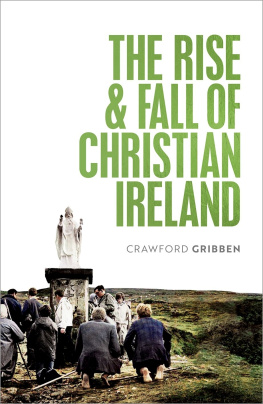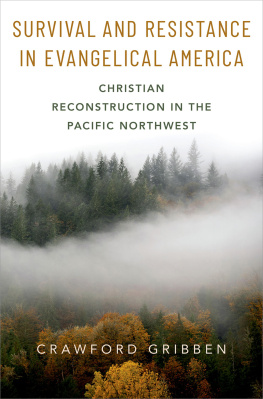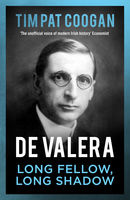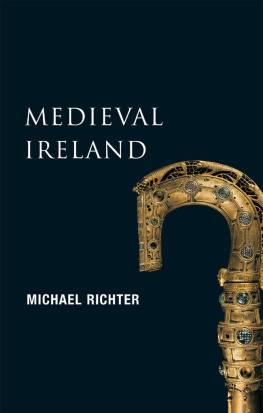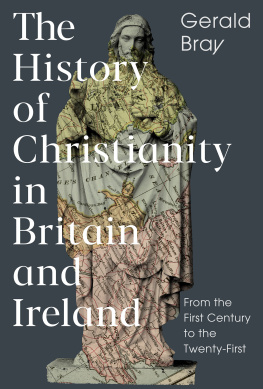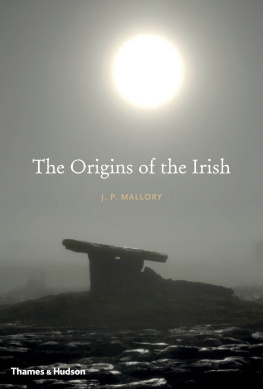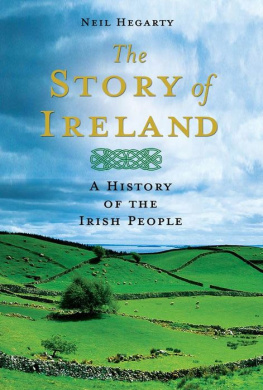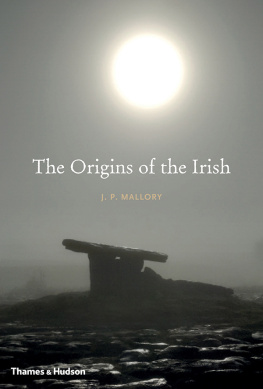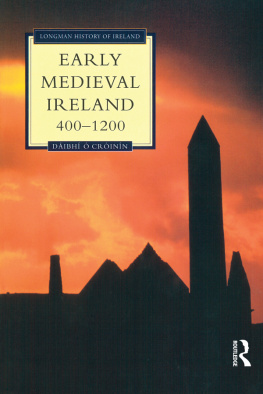The Rise and Fall of Christian Ireland

Great Clarendon Street, Oxford, ox 2 6 dp , United Kingdom
Oxford University Press is a department of the University of Oxford. It furthers the Universitys objective of excellence in research, scholarship, and education by publishing worldwide. Oxford is a registered trade mark of Oxford University Press in the UK and in certain other countries
Crawford Gribben 2021
The moral rights of the author have been asserted
First Edition published in 2021
Impression: 1
All rights reserved. No part of this publication may be reproduced, stored in a retrieval system, or transmitted, in any form or by any means, without the prior permission in writing of Oxford University Press, or as expressly permitted by law, by licence or under terms agreed with the appropriate reprographics rights organization. Enquiries concerning reproduction outside the scope of the above should be sent to the Rights Department, Oxford University Press, at the address above
You must not circulate this work in any other form and you must impose this same condition on any acquirer
Published in the United States of America by Oxford University Press
198 Madison Avenue, New York, NY 10016, United States of America
British Library Cataloguing in Publication Data
Data available
Library of Congress Control Number: 2021942140
ISBN 9780198868187
ebook ISBN 9780192638571
Printed and bound in Great Britain by
Clays Ltd, Elcograf S.p.A.
Links to third party websites are provided by Oxford in good faith and for information only. Oxford disclaims any responsibility for the materials contained in any third party website referenced in this work.
For Daniel, Honor, Finn, and Samuel
Preface and acknowledgements
Perhaps it is only now, after the collapse of Christian Ireland, that we can begin to recover its history. The rise and fall of Christian Ireland describes the slow emergence, long dominance, debilitating division and rapid decline of the communities of faith that for 1,500 years did most to shape and sustain the religious, social, and political life of this island and its people in their movements around the world. It shows how the beliefs and behaviours that sustained Christian Ireland went so long unquestioned and yet were so suddenly destroyedand how, in the aftermath of this sudden-onset secularization, while many Irish Christians have quite comfortably adapted to the new cultural landscape, and have appropriated its mores, others represent themselves as members of an increasingly powerless counter-culture, even as, in their adaption to this changing world, they have begun to evidence new signs of life.
I have written this book neither as elegy nor as eulogy. Published in the year that is both the 1500th anniversary of the birth of the islands most famous missionary, St Columba, and the one hundredth anniversary of the islands partition, this book has been, in part, a labour of love for the religious world in which I was formed. Growing up in a county Antrim family with a long history of commitment to the so-called Plymouth Brethren, in which I heard stories about fairies and accounts of charming, I grew to understand the possibility that widely held folk traditions, particularly in country areas, might point to the existence of a religious culture that in some respects includes a non-Christian supernatural and that in other respects transcends that faiths more recent divisions.
That might be an inauspicious way to begin to acknowledge my debts. This book draws upon almost three decades of conversations with friends and colleagues in literature, religion, and history at the University of Strathclyde, the University of Manchester, Trinity College Dublin, and Queens University Belfast. Over the years, those who have done most to stimulate (and, more often than not, correct) my thinking on this subject include Donald Akenson, Michael Brown, Jenny Butler, Eamon Cahill, James Cassidy, Marie Coleman, Philip Coleman, Niall Coll, Sean Connolly, Scott Dixon, Anne Dolan, John Dunne, Elaine Farrell, Maurice Fitzpatrick, Gladys Ganiel, Raymond Gillespie, Peter Gray, D. G. Hart, Gerard Howlin, Stephen Kelly, Jarlath Killeen, David Livingstone, David McKay, John Morrill, Graeme Murdock, Mary ODowd, Mchel Mainnn, Michel Siochr, Jane Ohlmeyer, Eve Patten, David Quinn, Ian Campbell Ross, Scott Spurlock, Timothy Stunt, Mark Sweetman, Mike Tardive, and Patrick Zuk. Sparky Booker, Matthew Brennan, Ian Campbell, Marie Coleman, and Elizabeth Dawson deserve special thanksif not actual canonizationfor reading and advising upon large parts of the text. I am enormously grateful to Salvador Ryan for his comments on the manuscript as a whole. And a very special thanks to Andrew Holmes, who on many happy occasions has challenged my methods, conclusions, evidence base, and almost everything else besides. The mistakes that continue to exist are entirely my own. For, as these friends will be only too aware, this book is too idiosyncratic in content; too fully organized; and too linear, perhaps even too teleological, in structure (though the title is a clue). As a short and necessarily selective survey, designed to be comprehensible rather than comprehensive, The rise and fall of Christian Ireland leaves many things unsaid.
Others have offered very practical assistance. I am extremely grateful to Matthew Cotton for commissioning this work, to the anonymous readers of the proposal, and to colleagues at Oxford University Press for guiding it through the process of production. Bill Hamilton of A.M. Heath has proved that the age of miracles has not ceased. Most of all I thank Pauline, who did more than anyone to make this project possible. I have written this book for our children, with love and in hope.
Crawford Gribben
Tulaigh na Mulln
Contents
Too long a sacrifice
Can make a stone of the heart
W.B. Yeats
And I will give you a new heart, and a new spirit I will put within you. And I will remove the heart of stone from your flesh and give you a heart of flesh.
Ezekiel 36:26
| c. 8000 bc | Mesolithic Ireland: arrival of first humans |
| c. 4000 bc | Neolithic Ireland: beginning of agricultural activity |
| c. 3000 bc | Construction of major megalithic tombs |
| c. 2500 bc | Bronze Age: arrival of Beaker People culture |
| c. 2000 bc | Deposition of Cashel Man |
| c. 300 bc | Iron Age: arrival of Celtic culture and deposition of Clonycavan Man |
| c. 2730 | Ministry of Jesus Christ |
| 312 | Conversion of Constantine |
| 313 | Edict of Milan allows for the toleration of Christianity |
| 380 | Edict of Thessalonica identifies Christianity as the official religion of the Roman empire |
| 381 | Nicene-Constantinopolitan creed |
| 407 | Roman army begins its withdrawal from the province of Britain |
| 410 | Rome sacked by Visigoths |
| 418 | Synod of Carthage rejects Pelagianism |
| 431 | Arrival of Palladius, with Patrick following |
| 521 | Birth of Columba |
| c. 52575 | Foundation of major monastic institutions and networks |

